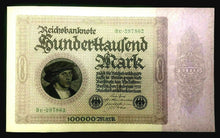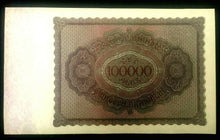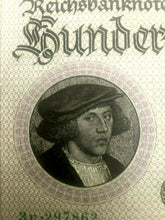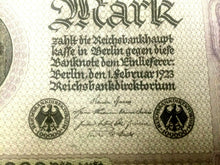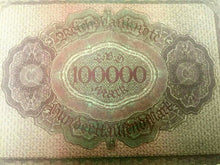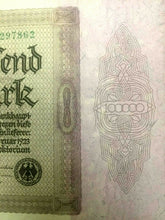
Vintage Authentic German - 100000 Reichs banknotes Printed in Berlin on 1 Feb 1923 UNC
1000000 Mark - Reichsbanknote Details
- Dimension - 190 mm × 115 mm (7.5 in × 4.5 in)
- Portrait - The portrait on the bill is of Merchant Georg Giese based on Der Kaufmann Georg Gisze by Hans Holbein the Younger.
- Merchant Georg Giese - Georg Giese[a] (2 April 1497 – 3 February 1562) was a prominent Hanseatic merchant, who managed his family's office at London's Steelyard for at least 12 years, and is noted for having had his portrait painted by Hans Holbein the Younger.
History Of Reichsbanknote
From August 1921, Germany began to buy foreign currency with marks at any price, but that only increased the speed of breakdown in the value of the mark. As the mark sank in international markets, more and more marks were required to buy the foreign currency that was demanded by the Reparations Commission. In the first half of 1922, the mark stabilized at about 320 marks per dollar. International reparations conferences were being held. One, in June 1922, was organized by US investment banker J. P. Morgan, Jr.[16] The meetings produced no workable solution, and inflation erupted into hyperinflation, the mark falling to 7,400 marks per US dollar by December 1922.[5] The cost-of-living index was 41 in June 1922 and 685 in December, a 15-fold increase. By fall 1922, Germany found itself unable to make reparations payments.[17] The mark was by now practically worthless, making it impossible for Germany to buy foreign exchange or gold using paper marks. Instead, reparations were to be paid in goods such as coal. In January 1923, French and Belgian troops occupied the industrial region of Germany in the Ruhr valley to ensure reparations payments. Inflation was exacerbated when workers in the Ruhr went on a general strike and the German government printed more money to continue paying for their passive resistance. By November 1923, the US dollar was worth 4,210,500,000,000 German marks. [ Source Wikipedia]
Item Details
The 100000 Mark German Bill for sale is from the above mentioned hyperinflation era. The bill is uncirculated and have consecutive numbers. These are stock picture but you will get exactly the same bills with the different sequence number. This bills is drawn from a uncirculated bundle of 20 bills. Its very hard to find this bill in such a good condition.
If you buy more than one bill then we will send SEQUENTIAL bills in a row.
Hold A Vintage and Authentic Pieces of history in your hands!.Great Investment!.
Note - To offer best price, this bill will be shipped via normal post without tracking number.





